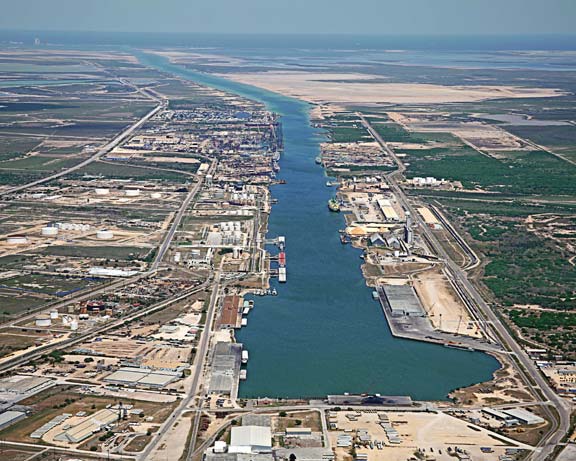IN THIS ISSUE:
Grantee Spotlight: LeMoyne Owen College Community Development Corporation Revitalizes Soulsville
Brownsville Aims to Become International Economic Hub
Facilitators of Change: OUP's Connections and Resources Transform and Empower Communities
Brownsville Aims to Become International Economic Hub

Enhancing the economic strength of the Port of Brownsville is an important part of the city’s comprehensive plan. Image courtesy of Port of Brownsville.
Brownsville, Texas has long sat in the shadow of the state’s industrial giants, Houston and San Antonio. Located just north of the Rio Grande River at the southernmost tip of the state’s Gulf Coast, the rapidly growing border city of nearly 200,000 residents has been plagued by high poverty rates, per capita incomes well below state and national averages, and low levels of educational attainment. Poorly coordinated infrastructure and land use decisions have failed to take advantage of the city’s chief economic drivers, the Port of Brownsville and the city’s location on the border of Mexico, which provide easy access to the rapidly growing economies of Latin America.
Re-imagining Brownsville
In 2007, city leaders and the public created a comprehensive plan for Brownsville’s future. The award-winning plan, Imagine Brownsville, marked an unprecedented effort to make the region more economically competitive by aligning and coordinating the interests of both the private and the public sectors. “Prior to the plan, we were all working in silos,” notes Irv Downing, vice president for Economic Development and Community Services at the University of Texas at Brownsville (UTB).
Less than four years after adopting the comprehensive plan, Brownsville is making significant progress toward reshaping its economic future. A key element of the Imagine Brownsville effort is to encourage economic development by expanding the Port of Brownsville’s cargo capacity, drawing industrial manufacturers to the port area, and improving the transportation of goods over land. The recently opened State Highway 550 provides a shortcut between the port and I-69, making Brownsville more attractive to both manufacturing and transportation. The port itself is expanding its freight capacity with the addition of a second marine cargo dock. Federal funds supported both projects, with the highway receiving $34 million through the American Recovery and Reinvestment Act of 2009 and the port expansion receiving a $12 million Transportation Investment Generating Economic Recovery (TIGER) grant from the U. S. Department of Transportation.
Along with projects aimed at improving the efficiency of trade in Brownsville, the city is also pursuing projects to bolster the industrial sector based around the port. Viewed as vital to the future of the city’s economy, the proposed 800-megawatt Tenaska Brownsville Generating Station would provide competitively priced electricity at the scale demanded by large manufacturers — a key need identified by business leaders in the comprehensive plan, according to Downing.
Investing in People
Although investments in infrastructure are critical to economic prosperity, developing human capital is equally important. Historically, the Brownsville region has suffered from low educational attainment, with a high percentage of the population lacking a high school diploma and a low percentage of residents holding post-secondary degrees.
UTB, in partnership with Texas Southmost College, has been key to ensuring that Brownsville companies have access to world-class research facilities and residents possess the skills that businesses demand. UTB’s Division of Economic Development and Community Services plays a critical role in promoting regional economic development. The Continuing Education Department provides various workforce development programs and courses that can be customized to meet industries’ needs. The International Innovation and Entrepreneurship Center provides resources and comprehensive education services to local entrepreneurs through the Kauffman Foundation’s FastTrac program.
An International City
Determined efforts to attract domestic and foreign investment are supporting the evolution of Brownsville’s economy. “We asked ourselves what we wanted to become,” says Gilberto Salinas, vice president of the Brownsville Economic Development Council (BEDC). The answer: an international city. Brownsville’s location provides strategic access to U.S. and Latin American markets. Efforts by BEDC and other leaders to aggressively recruit foreign investors are paying dividends; over the past decade, Brownsville has added between 200 and 400 high-paying jobs, with international and domestic business investments in the region exceeding $50 million. According to BEDC, an additional $11 billion in projects are in the pipeline, with the potential of adding approximately 5,000 new jobs to Brownsville’s economy.
With the development and implementation of the comprehensive plan and the city’s recent success in attracting businesses, leaders are hopeful that Brownsville will soon reach its economic potential. “Never in the history of Brownsville have we had plans with this much traction,” notes Salinas. This improved coordination should serve the city in the future. Brownsville is poised to benefit from the federal government’s recent decision to lease approximately 21 million acres in the Gulf of Mexico to oil and natural gas exploration. Meanwhile, local leaders will work to finance port improvements to accommodate the larger vessels that will pass through the expanded Panama Canal beginning in 2015, another potential boon to the region.


